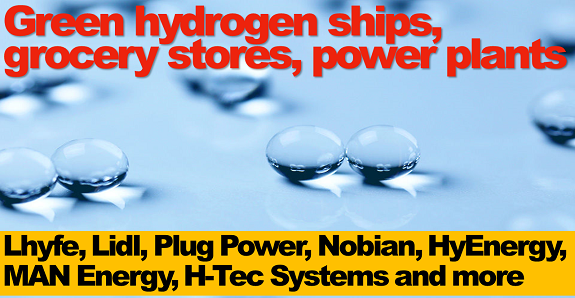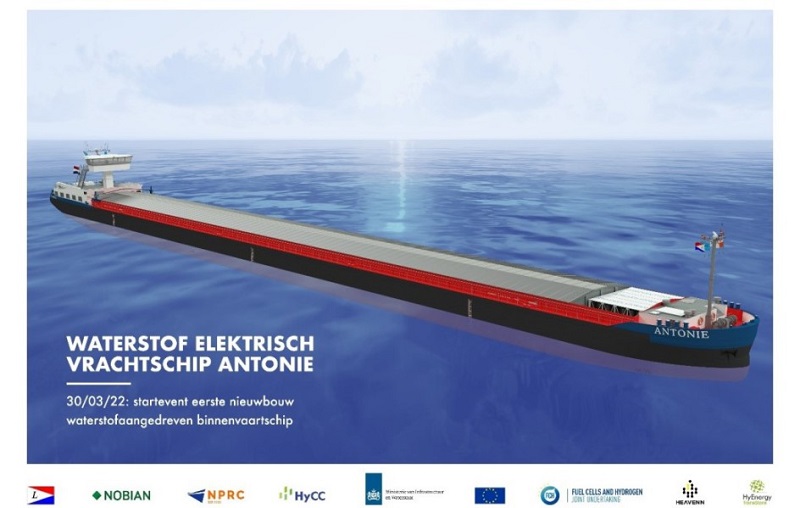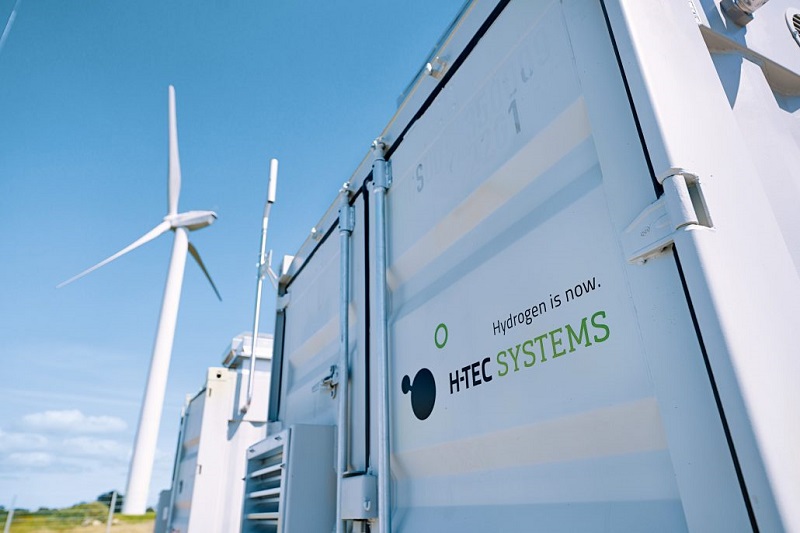Hydrogen heats up with green hydrogen ships, grocery stores, power plants and more

Hot hydrogen news hit the past few days with grocery store chain Lidl opening the first logistics platform in Europe to use renewable green hydrogen, thanks to its partners Lhyfe and Plug Power. Plus news from the Netherlands that Minister Harbers of Infrastructure and Public Works officially gave the starting signal for the construction of the ms Antonie, the first inland ship in Netherlands to run fully on green hydrogen.
On the other side of the planet was news about an international partnership to jointly develop, design, build, own and operate the world’s first fuel cell power plant that uses hydrogen produced from plastic waste in Ulsan, Korea. And in Germany, MAN Energy Solutions is investing up to 500 million Euro (over $550 million USD) in hydrogen production at H-TEC SYSTEMS, which has mastered one of the most important processes for industrially scaled hydrogen production from renewable energy sources.
In today’s Digest, the latest in hydrogen news, from waste-based hydrogen to seaweed-based hydrogen and more.
Lidl, Lhyfe, Plug Power
Let’s start with the news that grocery store chain Lidl opened the first logistics platform in Europe to use renewable green hydrogen, with partners Lhyfe and Plug Power, who they worked with to introduce a fleet of warehouse trucks running on renewable green hydrogen in Carquefou (Loire-Atlantique, France).
Why? Well, over the last 10 years Lidl has been on a mission to overhaul and improve its environmental impact and last year, the chain decided that the handling and lifting vehicles of its Carquefou platform would be powered by green hydrogen.
The platform in Carquefou, north of Nantes, is the first logistics platform to choose green hydrogen for the running of its warehouse trucks. Some 98 warehouse trucks (80% of the logistics fleet) have been running on renewable green hydrogen since January 2022.
Lidl sources its renewable green hydrogen from Lhyfe, a pioneer in the production of hydrogen from renewable and local energy sources, since the Lhyfe plant is located a few dozen kilometres from Carquefou. The availability of this green hydrogen, which is produced from seawater and renewable electricity, was the condition for carrying out this project which avoids using fossil fuels or electricity to power the vehicles.
To accompany Lidl in the realization of this project, the companies Lhyfe, Plug Power, HRS and Jungheinrich worked together closely to provide a tailor-made solution adapted to the needs of the Carquefou platform (preparation of classified installation application, design and implementation of indoor and outdoor equipment, adaptation of vehicles for hydrogen fuel cells, hydrogen needs forecast, etc.).
- Plug Power is a pioneer of the hydrogen fuel cell for the operation of warehouse trucks. More specifically, Plug Power, in collaboration with HRS and Jungheinrich, supplied the equipment needed to implement the hydrogen solution. Plug Power will also carry out the maintenance of all equipment on site.
- Lhyfe is a world pioneer and pure player in green hydrogen. As a green hydrogen producer, it delivers renewable, local hydrogen made 75 kilometres from the Lidl platform. To make this hydrogen, Lhyfe uses wind and water. A neighbouring wind farm supplies electricity while water is pumped in small quantities from the sea and then desalinated and purified. The electrolyser then separates the elements that make up water (hydrogen and oxygen) to produce green renewable hydrogen.
Lhyfe will guarantee the supply of the renewable green hydrogen necessary to operate the warehouse trucks, which represents 75 kilos a day at the platform’s busiest times. This large purchase volume – Lhyfe’s plant was producing 300 kilos at the end of 2021 and will produce a tonne a day by the end of 2023 – means Lidl is contributing to the development of the first French company producing green hydrogen.
2022 is just the beginning for green hydrogen at Lidl
In parallel, Lidl is already studying the possibility of developing green hydrogen as a solution to optimize its logistics and reduce its greenhouse gas emissions. In the medium term, Lidl plans to deploy green hydrogen trucks at other logistics platforms or even use it to power part of its fleet of delivery trucks.
Gregory Podda, Head of Logistics, Lidl France said, “Lidl is proud to be opening in Carquefou the first logistics platform in Europe to operate with green hydrogen thanks to its partners Plug Power, which adapted the warehouse trucks, and Lhyfe whose green hydrogen production plant is 75 kilometres from our site. With 98 warehouse trucks in operation and a delivery truck to come in 2022, Lidl believes in the future of green hydrogen for optimizing its logistics and lowering its CO2 emissions in keeping with its commitments”.
Julien Saleix, Regional Sales Manager, Plug Power said, “Hydrogen technology for handling vehicles is mature, deployed at 165 sites around the world and on more than 50,000 machines for the productivity gains that it brings. For the first time, the hydrogen used here is green, renewable hydrogen – Lidl is developing a more sustainable energy model. This Carquefou site integrates economic aspects and ambitious environmental objectives.”
Matthieu Guesné, CEO and founder of LHyfe said, “We are delighted with this partnership, which perfectly illustrates the multiple business interests – both in terms of responsibility and practicality – in switching to renewable green hydrogen. Following the transportation industry and public operators, Lidl is paving the way for renewable hydrogen in the world of logistics, transport and the private sector. This is a very promising turning point for energy transition”.
Why is Lidl looking at hydrogen?
Here’s what Lidl had to say about using hydrogen to optimize logistics:
- Filling a hydrogen truck takes just two to three minutes whereas a lead-acid battery takes several hours to charge. High availability of hydrogen vehicles (97% of the time compared to approximately 50% with lead-acid technology) means that the platform can save on parking space in the vehicle charging area.
- Three hydrogen refuelling points are sufficient for all of the warehouse trucks at the site. No dedicated space for charging is therefore needed.
- The performance and autonomy of warehouse trucks is constant throughout the life of the hydrogen fuel cell. The productivity of logistics operators is not dependent on battery age as could be the case with a lead-acid battery.
- Green hydrogen makes it possible to substantially decarbonize operations. It is produced from renewable energies and emits no CO2 or particles, either during its manufacture or its use.
- The lifespan of fuel cells is ten years, which is greater than that of lead-acid batteries (three to five years), so they need renewing less frequently than conventional vehicle batteries.
Sustainable shipping
Let’s look at the other big hydrogen news items from the past few days – that the Minister Harbers of Infrastructure and Public Works officially gave the starting signal for the construction of the ms Antonie, the first inland ship in Netherlands to run fully on green hydrogen.
It is expected that the ship will embark on its maiden voyage in mid-2023. The project is a partnership between Nedstack, Nobian, Lenten Scheepvaart, Concordia Damen, Energy TransStore and inland ship cooperative NPRC, and is contributing to the realization of fossil-fuel-free inland shipping.
The propulsion of an electric inland ship running on hydrogen is completely new and a demo project for Dutch inland navigation. The parties involved also want to use the project as a means to accelerate the drafting of legislation surrounding the use of hydrogen in inland shipping.
The experiences gained during the development phase, construction, and launch of the ms Antonie will contribute to determining the viability and costs of comparable projects in the future. The project allows for mapping what is necessary in terms of regulations and facilities in order to safely use hydrogen in inland shipping on a larger scale.
The costs for the construction and development of the first 135-metre-long hydrogen-electric inland ship are about twice as high as that of a regular ship. The Ministry of Infrastructure and Public Works is therefore making a significant contribution in order to cover the additional costs. The ministry views the project as an important part of realising the European goal of making all inland shipping emission-free by 2050.
When the ms Antonie is finished, the ship will transport salt for Nobian, the industrial chemistry branch of AkzoNobel which was spun off last year. The ship will transport approximately 3,700 tons of salt per voyage, the equivalent of 120 trucks, entirely free of emissions, from Delfzijl to the Botlek plant in Rotterdam. Nobian is also the producer of the green hydrogen. In addition to the involvement of Nobian, Lenten Scheepvaart, HyEnergy TransStore and the fuel cell producer Nedstack, the project is supervised by inland shipping cooperative NPRC, which is coordinating the supply of salt as the logistics service provider.
Mark Harbers, Minister of Infrastructure and Water Management said, “It makes me proud to kick-off the construction of the first inland vessel in the Netherlands to run fully on green hydrogen. This is an important step for the maritime sector towards CO2-free inland shipping. This is good for the climate, good for the future of inland shipping and good for the Dutch economy.”
Femke Brenninkmeijer, CEO of NPRC said, “NPRC has a long history when it comes to making water transport more sustainable. Working together as a cooperative with a long-term vision is always the starting point. Emission-free transport between Delfzijl and Rotterdam is the prime example of how we can live up to our climate promises together with all the companies in the chain, from entrepreneur to shipper. Together, we are now laying the keel for making water transport more sustainable, a strategic spearhead for NPRC in working towards the next generation supply chain.”
Michael Koenig, CEO of Nobian said, “Nobian intends to be climate-neutral by 2040. Greening the transport of our products is an important step towards this. We think it’s important to contribute to innovations in order to achieve scalable solutions for green transport, together with our partners. Additionally, Nobian wants to be a leader in the production and use of green hydrogen.”
Harm Lenten, Lenten Scheepvaart said, “The starting signal for construction is an important moment. After an intensive period of feasibility studies, preparations, and other paperwork, this is when everything we developed on paper becomes visible in reality. It’s now really about to happen and I’m already looking forward to travelling the first kilometres through the Netherlands silently and without emissions.”
Ian Williamson, Managing Director HyEnergy TransStore said, “We’re proud to be part of the WEVA project. Selecting and building the best hydrogen technology in order to realise new, innovative, and emissions-free applications is our strength. Together with our partners at WEVA, we helped create a new and functional hydrogen value chain. We look forward to seeing the ms Antonie as the example for many ships to follow.”

International partnership to deliver zero combustion power from hydrogen to Asia
Breaking news also came in recently that SGH2 Energy Global, GS E&C and KOSPO/Southern Power signed a Memorandum of Understanding to jointly develop, design, build, own and operate the world’s first fuel cell power plant that uses hydrogen produced from plastic waste in Ulsan, Korea.
The Ulsan Plastics to H2 Power (ULSAN H2) Project will feature SGH2’s proprietary plasma-enhanced gasification technology (SPEG), which will use plastic waste to create hydrogen as a fuel to replace natural gas and coal for power production and reduces both carbon emissions and air pollutants from the combustion of fossil fuels like NOx, SOx and lung-damaging particulate matter. Hydrogen produced by SPEG is three times cheaper to produce than hydrogen produced using electrolysis. SGH2 hydrogen is cost competitive with “grey” hydrogen produced from fossil fuels like natural gas.
“This project demonstrates how our technology can fight two of the world’s biggest environmental problems at once,” said Dr. Robert T. Do, CEO of SGH2 Energy Global. “We will keep polluting plastics out of our oceans, landfills and the food chain and use it instead to produce zero-carbon electricity that is necessary for fighting the climate crisis. The Ulsan project is exemplary of Korea’s commitment to protecting the environment and moving away from imported fossil fuels.”
The plant will produce 99.9999% pure hydrogen that will be fed into a stationary fuel cell facility for zero-combustion power generation. As a major Korean port city, Ulsan is capable of providing a steady, large-scale supply of industrial waste plastic as feedstock. The power generated by the stationary, zero-combustion fuel cell system will be purchased by KOSPO/Southern Power, a major electric utility and an affiliate of KEPCO through a long-term power purchasing agreement.
Deploying SGH2 Energy’s standard modular facility, the Ulsan H2 project has the capacity to produce 3,850 tons of clean hydrogen per year from 40,000 tons per year of mixed plastics waste and an estimated gross power production capacity of 7.5 MWh or 60 GWh/annually. The $140 million project will undergo front end engineering design work and permitting in Q4 2022 and scheduled for start up and operation in 2025.
SGH2 Energy Global, LLC is focused on the gasification of waste into hydrogen and holds the exclusive rights to build, own and operate SPEG technology to produce green hydrogen. SGH2 has projects in development around the world including the SGH2 Lancaster Project in California. SGH2 Energy and the City of Lancaster are launching the California’s first closed-loop green hydrogen ecosystem for transportation to supply Hydrogen Refueling Stations in Los Angeles.
Other hydrogen news
A few other recent items to note, E.ON and Tree Energy Solutions (TES) want to drive the ramp-up of the future hydrogen economy jointly and agreed on a strategic partnership to import green hydrogen at scale into Germany. Within the framework of the partnership the companies will investigate potential joint engagements along the entire hydrogen value chain to build a source for secure, long-term green hydrogen supply.
Other news also from Germany is that over the next few years, MAN Energy Solutions will invest up to 500 million euro (over $550 million USD) in its subsidiary H-TEC SYSTEMS to transform the hydrogen specialist into a mass-producer of PEM electrolysers as quickly as possible. “Our plan is clear,” explained Uwe Lauber, CEO of MAN Energy Solutions. “We are transforming H-TEC SYSTEMS into one of the world’s leading players in the field of PEM electrolysis. Over the next five to ten years, green hydrogen will become one of the most important primary energy sources for the global economy as it continues to decarbonize. With PEM electrolysis, H-TEC SYSTEMS has mastered one of the most important processes for industrially scaled hydrogen production from renewable energy sources. The technology is mature and has already been placed on the market successfully. The next step is therefore to scale and set up highly automated serial production – and we would like to make rapid progress with this.”

Bottom Line
We’ve been saying for a while that hydrogen is hot, and this past week of hydrogen news just reinforced this. But this is just the tip of the iceberg and don’t be surprised if more green hydrogen projects, tech developments, improved efficiencies, partnerships and market movement arises in 2022.
Category: Top Stories















